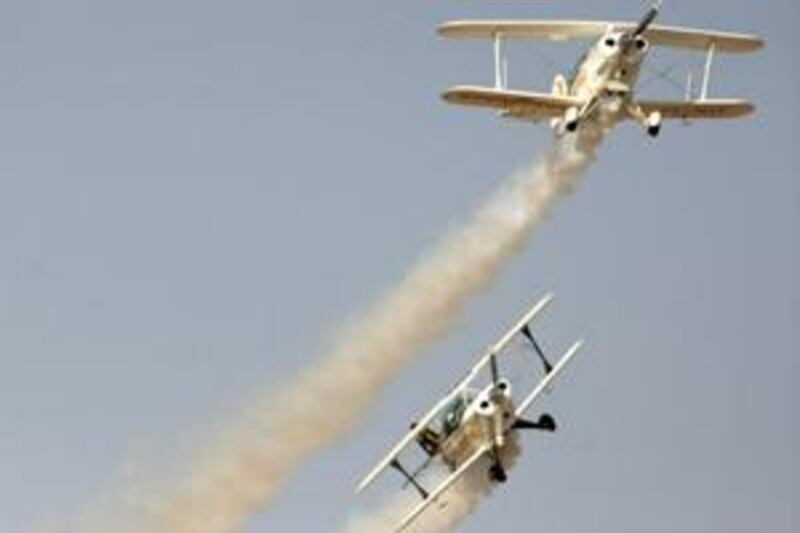The entire concept seems crazy. Not the ordinary craziness of daredevil flying in an aerobatic plane, but the supersized craziness of parachuting out of one as it is flying - upside down. At the same time as two other parachutists.
"It's not an easy manoeuvre," concedes Dennis Spence, in epic understatement. "There is some risk involved." It is a risk that the Goodyear Eagles from South Africa are willing to accept to become the first aerobatic team to execute a triple synchronised inverted parachute drop in a public setting. As the sound of propellers echoed behind the grandstand on the eve of the Al Ain Aerobatic Show yesterday, all eyes scanned the sky.
Three Pitts Special S2B planes, with cockpit canopies removed, suddenly appeared. At 760 metres, the pilots dove at 340 kph before pulling up steeply and into a loop. Inside each plane, a skydiver not strapped in was holding on for dear life. As the planes neared the apex of the loop, three men appeared to narrowly miss the tail of the aircraft as they jumped or, more accurately, fell out of the upside-down planes.
Within seconds, two orange and one South African-flag-coloured parachutes opened as the skydivers serenely descended, trailing blue-and-yellow streamers behind them. It was a sneak preview of a triple synchronised inverted parachute drop, the Eagles' newest stunt. So new, it was only the third time they had performed it. And the first had come only three days before. "To my knowledge this is the first time in the world this has been done in the Pitts Special biplane," said Mr Spence, the leader of the six-man team.
Graham Field, 44, is one of the three skydivers. Sporting bleached-blond hair and tattoos, he has performed approximately 4,400 jumps. But he was particularly excited about this one. "We sit normally in the aircraft except for the fact that we are not wearing a safety harness or seat belt," he said. "As we prepare to exit the aircraft, we sit on our haunches in the cockpit, sticking the top half of our bodies out and holding on to the wing struts while crouching behind the windshield.
"Just as we are about to launch, we put our knees together and our feet together and we push down quite firmly against the floor and we pop out upside down and headfirst, looking down at the earth." If the skydivers jump too early they could strike the tail of the plane. But that is not the only danger. With three skydivers jumping out of three airplanes each going a different direction, the skydivers risk the danger of collision before their chutes deploy. And there are no automatic chute-activation devices.
"The most dangerous part of the jump is not exiting the aircraft, it's deploying our parachutes in close proximity to one another," Mr Field said. "Deploying the parachute while heading towards another skydiver is the most dangerous part of the jump. That's the trickiest part." Mr Spence, 60, said it was the pilots who decide when the skydivers leave the plane. "We stop the aircraft on the horizon pushing negative Gs and we hold it there," he said. "By pushing negative Gs the parachutist is ejected like a bullet out of the airplane.
"It's like hanging upside down from a ceiling and letting go. The skydiver drops from in front of us so there is a little element of risk if he exits too early or too late. "We've shown the skydivers where the inverted position is, where they've got to exit when they feel light." Mr Spence said the Eagles first tried the upside-down jump with Mr Field, the most-experienced jumper, then added jumper Ricci Bucceri before deciding to make it a three-man drop.
"We have to do the drop from a fairly high altitude for safety reasons," Mr Spence said, "in case there is a malfunction with the parachute." All three skydivers, Johan Grobler, 38; Mr Bucceri, 46, and Mr Field, hail from South Africa and have made thousands of jumps each. All three also have day jobs. Mr Field is an architect and owns a skydiving school; Mr Grobler is in the information-technology field; and Mr Bucceri works in security.
Glenn Warden, 54, the number two pilot, choreographed the team's aerobatic display. "We do a lot of opposition passes and try to keep the dynamics moving, always with changing geometry using the three aircraft," Mr Warden said. "At one point the aircraft are together in formation, then we split off, then cross over, then come back together. We complete the exercise with a heart in the sky with Cupid's arrow flying through it."
Mr Spence does not try to diminish the risks of his sport. "Everything is done with a level of experience and risk-management," he said. "We analyse each and every manoeuvre asking where is our risk, where is our exposure, what is good, what is bad and we study the aesthetics of the whole thing. "Worldwide this is a unique act and I don't think anyone has really thought of it except maybe us." He said the team was determined to treat fans at Al Ain to a novel stunt.
"We wanted to do something unusual because with air shows spectators might say, 'Well we've seen that same manoeuvre done before but with another airplane.' No members of the public will have ever seen the triple synchronised inverted parachute drop performed before." The pilots, who also include Neil Trollip, 44, also have jobs, working for various South African airlines as pilots. The Goodyear Eagles team will perform every day of the air show, which runs through Saturday. The team performed previously in Al Ain in 2008. Approximately 110,000 visitors are expected to attend the show this year.
ealghalib@thenational.ae






